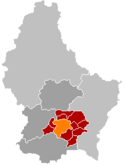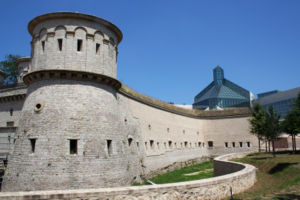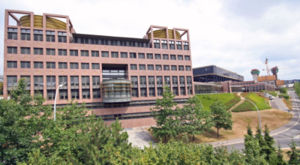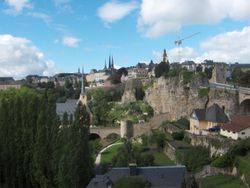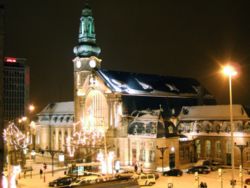Luxembourg (city)
2007 Schools Wikipedia Selection. Related subjects: European Geography
The city of Luxembourg (as its French name; sometimes Luxemburg as its German name; in Luxembourgish: Lëtzebuerg), commonly known as Luxembourg City, is a commune with city status, and the capital of the Grand Duchy of Luxembourg. It is located at the confluence of the Alzette and Pétrusse rivers in southern Luxembourg
As of 2005, the commune of Luxembourg City has a population of 76,420, which is almost three times the population of the second most populous commune. The city's metropolitan population, including that of surrounding communes of Hesperange, Sandweiler, Strassen, and Walferdange, is 103,973. Luxembourg City lies at the heart of Western Europe, situated 188 km (117 miles) from Brussels, 289 km (179 miles) from Paris, 190 km (118 miles) from Cologne.
Luxembourg City is one of the wealthiest cities in the world, having developed into a banking and administrative centre. Luxembourg is a seat of several institutions of the European Union, including the European Court of Justice, the European Court of Auditors, and the European Investment Bank.
History
In the Roman era, a fortified tower guarded the crossing of two Roman roads that met at the site of Luxembourg city. Through an exchange treaty with the abbey of Saint Maximin in Trier in 963, Siegfried I of the Ardennes, a close relative of King Louis II of France and Emperor Otto the Great, acquired the feudal lands of Luxembourg. Siegfried built his castle, named Lucilinburhuc ("small castle"), on the Bock Fiels ("rock"), mentioned for the first time in the aforementioned exchange treaty.
In 987, the Archbishop of Trier, Egbert ( 977- 993), blessed five altars in the Church of the Redemption (today St. Michael's Church). At a Roman road intersection near the church, a marketplace appeared around which the city developed.
The city, for reasons of its location and natural geography, has through history been a place of strategic military significance. The first fortifications were built as early as the 10th century. By the end of the 12th century, as the city expanded westward around the new St. Nicholas Church (today the cathedral of Notre Dame), new walls were built that included an area of 50,000 m².
In about 1340, under the reign of John the Blind, new fortifications were built that stood until 1867.
In 1443, the Burgundians under Philip the Good conquered Luxembourg. Luxembourg became part of the Burgundian, and later Spanish and Austrian empires. By the 16th century, Luxembourg was one of the strongest fortifications in Europe. Subsequently, the Burgundians, the Spanish, the French, the Spanish again, the Austrians, the French again, and the Prussians conquered Luxembourg.
In the 17th century, the first casemates were built; initially, Spain built 23 km of tunnels, starting in 1644. These were then enlarged under French rule by Marshal Vauban, and augmented again under Austrian rule in the 1730s and 1740s. By the late eighteenth century, Luxembourg's fame as an impregnable fortress was such that it became known as the Gibraltar of the North, second to only Gibraltar itself.
In 1795, Luxembourg was annexed into the French Republic as part of the département of Forêts, with Luxembourg City as its préfecture. Under the 1815 Treaty of Paris, which ended the Napoleonic Wars, Luxembourg City was placed under Prussian military control as a part of the German Confederation, although sovereignty passed to the House of Orange-Nassau, in personal union with the United Kingdom of the Netherlands.
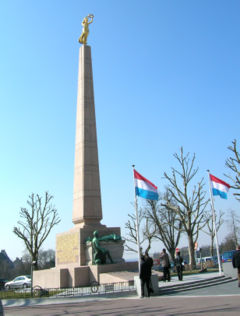
After the Luxembourg Crisis, the 1867 Treaty of London required Luxembourg to dismantle the fortifications in Luxembourg City. Their demolition took sixteen years, cost 1.5m gold francs, and required the destruction of over 24 km (15 miles) of underground defences and 40,000m² (10 acres) of casemates, batteries, barracks, etc. Furthermore, the Prussian garrison was to be withdrawn.
When, in 1890, Grand Duke William III died without any male heirs, the Grand Duchy passed out of Dutch hands, and into an independent line under Grand Duke Adolphe. Thus, Luxembourg, which had hitherto been independent in theory only, became a truly independent country, and Luxembourg City regained some of the importance that it had lost in 1867 by becoming the capital of a fully independent state.
Despite Luxembourg's best efforts to remain neutral in the First World War, it was occupied by Germany on 2 August 1914. On 30 August, Helmuth von Moltke moved his headquarters to Luxembourg City, closer to his armies in France in preparation for a swift victory. However, the victory never came, and Luxembourg would play host to the German high command for another four years. At the end of the occupation, Luxembourg City was the scene of an attempted communist revolution; on 9 November 1918, communists declared a socialist republic, but it lasted only a few hours.
In 1921, the city limits were greatly expanded. The communes of Eich, Hamm, Hollerich, and Rollingergrund were annexed into Luxembourg City, making the city the largest commune in the country (a position that it would hold until 1978).
In 1940, Germany occupied Luxembourg again. The Nazis were not prepared to allow Luxembourgers self-government, and gradually integrated Luxembourg into the Third Reich until it annexed the Grand Duchy, on 30 August 1942. Luxembourg City was liberated on 10 September 1944.
After the war, Luxembourg ended its neutrality, and became a founding member of several inter-governmental and supra-governmental institutions. In 1952, the city became the headquarters of the High Authority of the European Coal and Steel Community. In 1967, the High Authority was merged with the commissions of the other European institutions; although Luxembourg City would no longer be the seat of the ECSC, it would play host to some part-sessions of the European Parliament until 1981. Luxembourg remains the seat of the European Parliament's secretariat, as well as the European Court of Justice, the European Court of Auditors, and the European Investment Bank.
Geography and climate
Luxembourg City lies on the southern part of the Luxembourg plateau, a large Early Jurassic sandstone formation that forms the heart of the Gutland, a low-lying and flat area that covers the southern two-thirds of the country.
The city centre occupies a picturesque site on a salient, perched high atop precipitous cliffs that drop into the narrow valleys of the Alzette and Pétrusse rivers, which find their confluence at Luxembourg City. The 70 m- (230 foot) deep gorge cut by the Alzette is spanned by many bridges and viaducts, including the Adolphe Bridge, the Grand Duchess Charlotte Bridge. Although Luxembourg City is not particularly large, its layout is complex, as the city is set on several levels, straddling hills and dropping into the two gorges.
The commune of Luxembourg City covers a total area of over 51 km², or 2% of the Grand Duchy's total area. This makes the city the fourth-largest commune in Luxembourg, and by far the largest urban area. Luxembourg City is not particularly densely-populated, at under 1,500 people per km²; large areas of Luxembourg City are maintained as parks, forested areas, or sites of important heritage (particularly the UNESCO sites), while there are also large tracts of farmland that lie within the city limits.
Quarters of Luxembourg City
Luxembourg City is subdivided into twenty-four quarters, which cover the commune in its entirety. The quarters generally correspond to the major neighbourhoods and suburbs of Luxembourg City, although a few of the historic districts, such as Bonnevoie, are divided between two quarters.
Climate
Luxembourg City has a mild continental climate, marked by high precipitation.
| Jan | Feb | Mar | Apr | May | Jun | Jul | Aug | Sep | Oct | Nov | Dec | |
|---|---|---|---|---|---|---|---|---|---|---|---|---|
| Mean daily maximum temperature ( °C) | 3 | 4 | 10 | 14 | 18 | 21 | 23 | 22 | 19 | 13 | 7 | 4 |
| Mean daily minimum temperature ( °C) | -1 | -1 | 1 | 4 | 8 | 11 | 13 | 12 | 10 | 6 | 3 | 0 |
| Mean total rainfall ( mm) | 61 | 65 | 42 | 47 | 64 | 64 | 60 | 84 | 72 | 53 | 67 | 81 |
| Mean number of rain days (0.25mm+) | 20 | 16 | 14 | 13 | 15 | 14 | 14 | 15 | 16 | 15 | 19 | 20 |
| Average sunshine (hours per day) | 1 | 2 | 5 | 6 | 6 | 6 | 6 | 6 | 5 | 3 | 1 | 1 |
| Source: BBC Weather | ||||||||||||
Places of interest
Places of interest include the neogothic Cathedral of Notre Dame, the fortifications, the Grand Ducal Palace, the Gëlle Fra war memorial, the casemates, the Neumünster Abbey, the Place d'Armes, the Adolphe Bridge and the city hall. The city is the home of the University of Luxembourg and Radio Luxembourg.
Luxembourg City is also the seat of several institutions of the European Union, including the European Court of Justice, the secretariat of the European Parliament, the European Court of Auditors and the European Investment Bank. The majority of these institutions are located in the Kirchberg quarter, in the northeast of the city.
The Second World War Luxembourg American Cemetery and Memorial is located within the city limits of Luxembourg. This cemetery is the final resting place of 5,076 American military dead, including General George S. Patton. There is also a memorial to 371 Americans whose remains were never recovered or identified.
Twin towns
 Camden, the United Kingdom
Camden, the United Kingdom Metz, France
Metz, France

